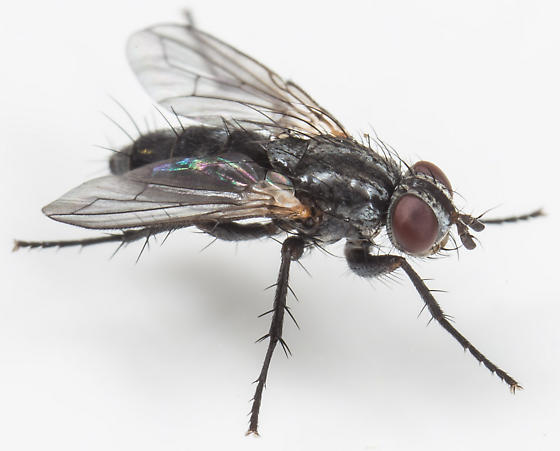 |
| The adult McAlpine's Fly: B, D, F, and G show female features; the remainder, male (Michelsen & Pape, 2017) |
Ferrar (1979) did not describe the adults, but cited personal communications that they most closely resembled the Anthomyiidae, with male genitalia exhibiting "one or two characters" (Ferrar, 1979) more reminiscent of the Calliphoridae (blowflies), in this sense including both the Rhiniidae and Mesembrinellidae (now each having familial status; Kutty et al., 2010; Marinho et al., 2016). Ferrar (1979) concluded on the basis of both larval biology (sedentary and exclusively dung-feeding) and third-instar larval morphology (radiating slits around posterior spiracles) that "McAlpine's Fly", as it became known, could provisionally be considered an anthomyiid.
 |
| Mystacinobia zelandica photographed by Rod Morris |
 |
| Stevenia deceptoria (Rhinophoridae), photographed by John Rosenfeld |
While it seems entirely reasonable to place Ulurumyia in its own family, that family's phylogenetic position among the Oestroidea remains a topic of debate. Unpublished transcriptomic data hints not at a sister-group relationship with the Mystacinobiidae, but at kinship with the Calliphoridae sensu lato (Michelsen & Pape, 2017). Specifically, phylogenetic analysis of the Oestroidea suggests with medium to high support (disregarding model) a sister-group relationship between the Ulurumyiidae and Mesembrinellidae (Cerretti et al., 2017). While I do not find these results as compelling as I would like (read the paper), it is interesting that all Mesembrinellidae so far as known also practice larviparity (albeit of the pseudo-placental* variety; Meier et al., 1999).
A very happy Boxing Day to you all.
*Feeding exclusively on egg yolk, with the larva hatching from an egg within its mother. This contrasts with pseudo-placental larviparity, in which case larvae subsist on specialized secretions produced by their mother (Meier et al., 1999). The latter condition is a famed trait of the Hippoboscoidea.
†Cooperative brood care among individuals of the same generation, without reproductive division of labor.
‡Ventral sclerites of the insect abdomen. Sternites are numbered according to the segment with which they are associated (antero-posterior).
______________________________________________________________
Cerretti, P.; Stireman, J. O.; Pape, T.; O'Hara, J. E.; Marinho, M. A. T.; Rognes, K.; and Grimaldi, D. A. (2017). First fossil of an oestroid fly (Diptera: Calyptratae: Oestroidea) and the dating of oestroid divergences. PLoS One, https://doi.org/10.1371/journal.pone.0182101
Ferrar, P. (1987). A Guide to the Breeding Habits and Immature Stages of Diptera Cyclorrhapha. Entomonograph, 8(1-2). Leiden and Copenhagen: Scandinavian Science Press/E. J. Brill.
Holloway, B. A. (1976). A new bat-fly family from New Zealand (Diptera: Mystacinobiidae). New Zealand Journal of Zoology, 3, 279-301.
Kutty, S. N.; Pape, T.; Wiegmann, B. M.; and Meier, R. (2017). Molecular phylogeny of the Calyptratae (Diptera: Cyclorrhapha) with an emphasis on the superfamily Oestroidea and the position of Mystacinobiidae and McAlpine’s fly. Systematic Entomology, 35, 614-635.
Marinho, M. A. T.; Wolff, M.; Ramos-Pastrana, Y.; de Azeredo-Espin, A. M. L.; and Amorim, D. S. (2016). The first phylogenetic study of Mesembrinellidae (Diptera: Oestroidea) based on molecular data: clades and congruence with morphological characters. Cladistics, 33(2), 134-152.
Meier, R.; Kotrba, M.; and Ferrar, P. (1999). Ovoviviparity and viviparity in the Diptera. Biological Reviews, 74, 199-258.
Michelsen, V. and Pape, T. (2017). Ulurumyiidae-a new family of calyptrate flies. Systematic Entomology, 42(4), 826-836.
No comments:
Post a Comment